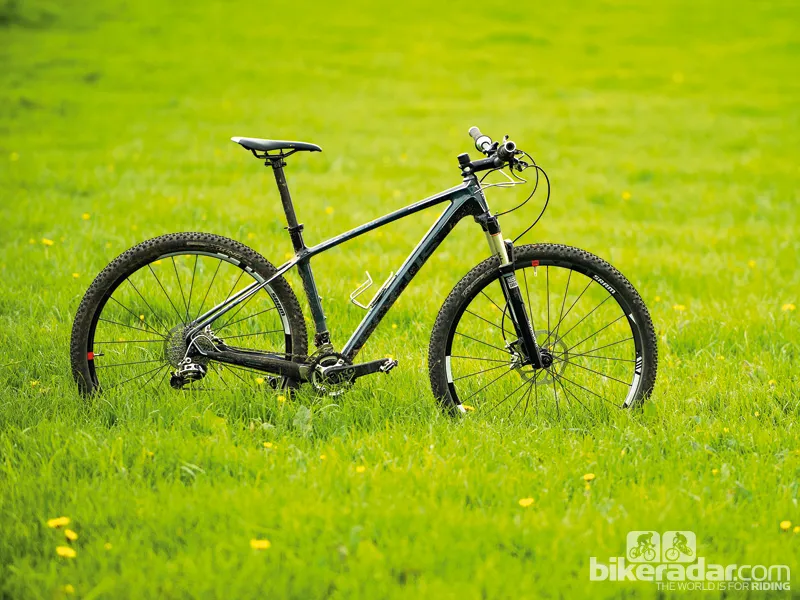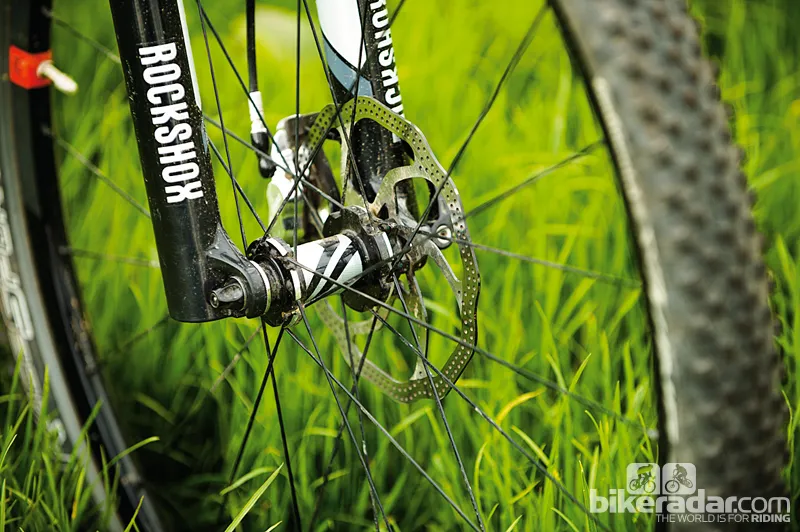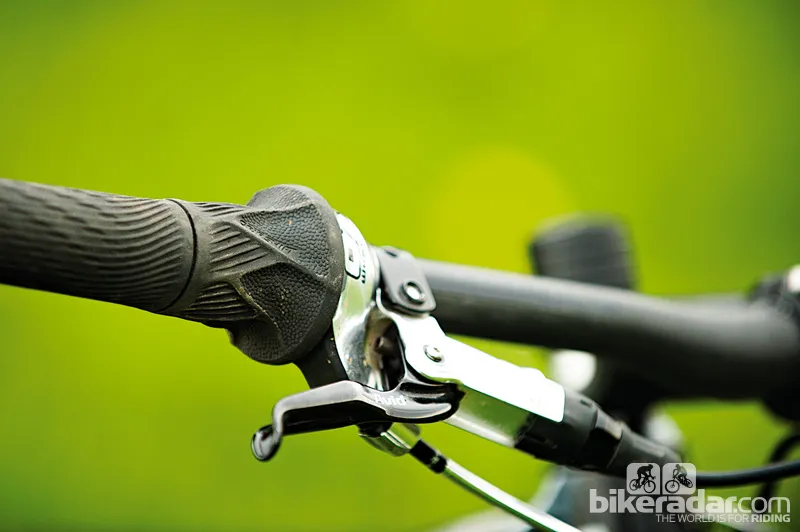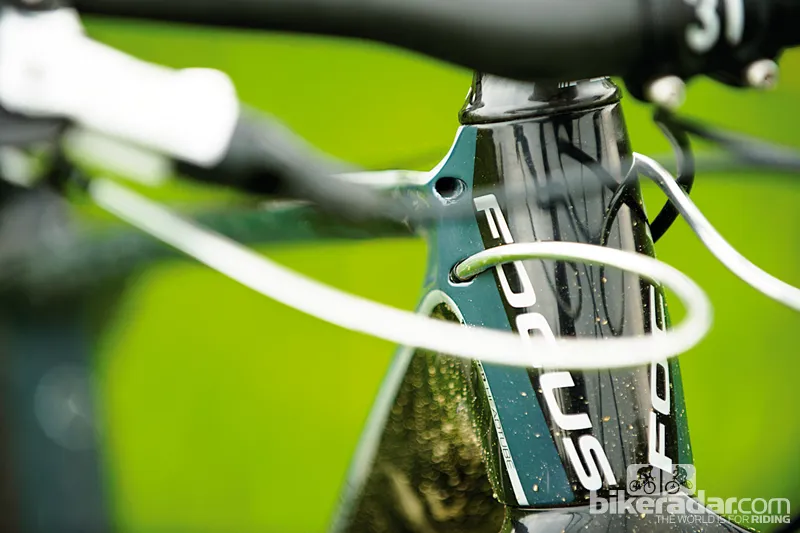Focus produce a whole flock of Ravens – the range includes five 26ers, one 650b bike and six 29ers. The Raven 29R 3.0 sits in the middle of their big-wheeler range, mixing an impressively fast but not punishing frame with an eclectic kit mix.
Ride & handling: Powerful and racy
Turn up to a cross-country race and you’ll find the front end of the field dominated by big-wheeled hardtails. They’re still lighter than full-suspension bikes for a strong startline snap and grinding out fireroad climbs, but they’re noticeably faster, smoother and more controlled on rough sections and descents than a 26in-wheeled hardtail. That’s literally race-proven.
The Raven frame is designed to put you at the sharp end of a race pack, but it’s got potential to do much more than that. It can handle as much shoulder wrestling as you want to put through the super-wide handlebar and SRAM double chainset.
The short, tapered head tube flows into broad, flat seatstays. Add an oversized down tube that leads to an equally big, press-fit BB30 bottom bracket and super-deep chainstays and your wattage isn’t going to get wasted.
The racers’ favourite Schwalbe Racing Ralph semi-slick rear tyre means the Raven is gagging to punch clear of the pack from the second that you clip into the pedals. The powerful delivery and low overall weight mean just a couple of clear metres are enough to really catapult you forward past any other riders in your way. It’s also really easy to keep those sudden speed gains topped up, thanks to the smooth-rolling abilities of those big wheels.

Focus Raven 29R 3.0
The plunger-actuated fork lockout means you don’t have to tone it down on smooth-trail climbs or finishing sprints just to stop fork bounce; you can just go balls out for the win.
It’s a mark of just how fast this bike is that the 38-tooth outer ring on the SRAM double chainset, which we’d normally consider a serious feat of over-gearing on a wagon wheeler, feels exactly right – it’s perfect for fully exploiting the speed of the Raven.
Frame & equipment: Rigid but with a QR fork and unusual bar
It’s not just a brutally rigid race frame. While the top tube and stays are very broad from above, they’re super-thin when viewed side on. The rear stays also extend further back than the dropouts, in a deliberate elbow that increases the length of the seatstays and makes room for the post-mount rear brake on the chainstay.
This all adds a significant amount of bump-damping vertical flex and gives a genuine float over rough surfaces – ones that would rattle stiffer bikes into a stammering, staccato stall.
What’s really impressive is that, thanks to a stiff, full-size seatpost and cunning tube design, the flex feels like damped ‘micro suspension’ rather than power and morale sapping bounce. This is really obvious when you’re determined to grunt a gear through mud or up a steep, loose climb that would set a skinny seatpost swaying.
Internal gear and brake lines that dive into the head tube and only emerge at the far end of the stays make for really clean-looking lines; lines that cling onto noticeably less mud while you’re crossing the grass and gunk.
There’s also a metal anti-chainsuck plate behind the big bottom bracket, and you even get internal routing for a dropper post if you’re feeling rad, although it creates a very sharp loop.
That dropper compatibility points to a more versatile character than just racing, and several other spec choices back that up. The 3T Extendo bar is a weird cowhorn shape but add masses of steering leverage, and the SRAM X0 Trail brakes use four-piston callipers (instead of two) for a bit more bite and a lot more feel in technical situations.

The Reba RL’s quick-release axle is a spec mis-step
Unfortunately, the Reba RL fork ends with a quick-release axle. Even with the oversized end caps on the SRAM hubs, it creates noticeably more wheel yaw and flop when you’re pushing hard across ruts, roots or off-cambers than a 15mm thru-axle. And it’s even more obvious thanks to the extra-wide bar leverage and the lurching turn manners of the relatively long stem.
The carbon 3T post also gets an inline clamp that forces body weight forward – all this is great for straight line power climbing, where the Raven really excels. But it creates more trip-up potential on descents or tighter trails, and the bike really feels more balanced and playful with a 720mm flat bar and 70mm stem. The SRAM X0 gears get Grip Shift, for minimum bar mass and instinctive operation via matching, chrome-finished cable outers.
The whole thing rolls on SRAM’s Rise 40 alloy wheels, which are reasonably tight and a bearable weight, while a broad-range cassette keeps you spinning when others are stumbling.
We always say the frame is the most important part of any bike, and the Raven frame is a belter; seriously fast yet smooth enough to minimise fatigue and maximise control. It’s also got the potential to be go beyond a race weapon to be an extremely versatile and enjoyable bike for blitzing trails.
However, there are some odd aspects to the 3.0 – not least the bar and QR-axled fork – that would lead us to look elsewhere in the range for the ideal Raven to go raving on.
This article was originally published in What Mountain Bike magazine, available on Apple Newsstand and Zinio.





